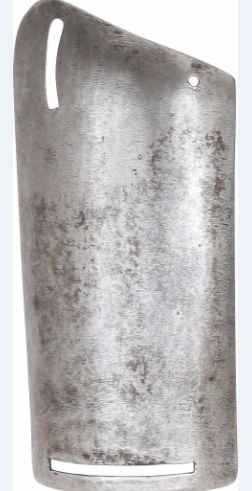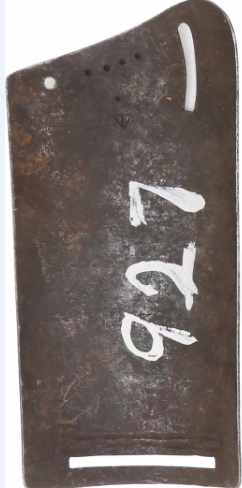| Author |
Message |
|
Tom Wolfe
Location: East Anglia, England Joined: 10 Aug 2015
Posts: 83
|
 Posted: Wed 14 Oct, 2015 9:22 am Post subject: Dating splint armour Posted: Wed 14 Oct, 2015 9:22 am Post subject: Dating splint armour |
 |
|
My understanding of splint armour has always been in the context of mainly 14th century transitional armour, or a bit earlier with regard to "splinted maille". Essentially the precursor to what you might refer to as "full plate" white armour.
That being the case, I am surprised to see some pieces described as "splint armour" of lower arm, for sale from a well-known dealer in the USA, which the dealer is dating to c1480-1510. He is a dealer who knows his stuff, so I don't doubt the dating or attribution, so it appears my knowledge is badly wrong.
Measurements: 7" x 3 1/4" Picture shows interior and exterior.
How late did splint armour of this kind persist in use in Western Europe?
Thanks!
 Attachment: 40.3 KB Attachment: 40.3 KB

 Attachment: 37.8 KB Attachment: 37.8 KB

Collector of original 16th-17th century European arms and armour. Would like to collect earlier, but budget doesn't allow- yet!
|
|
  |
 |
|
Matthew Amt
|
 Posted: Wed 14 Oct, 2015 12:28 pm Post subject: Posted: Wed 14 Oct, 2015 12:28 pm Post subject: |
 |
|
Part of the confusion is that early on we have "splinted armor", meaning narrow strips of (usually) metal riveted to strips or a solid piece of leather. Lots of that in the 14th century, and it shows up here and there in the Migration Era as well.
But then at least by the 16th century and possibly before (not sure!), we have "splints" or "pair of splints" which refer to arm defences made of several articulated plates. I *think* it's usually a term for munition armor, but other folks know this all a lot better.
So you might be able to differentiate "splinted armor" from "armor splints", but I suspect there still could be some confusion... In any case, if the dealer says this is a "splint" from c. 1500, that makes sense to me: it's from a munition armor for the arm. It just isn't made the same way as the modern term for "splints" meaning narrow strips, because the period usage of the term was different.
Matthew
|
|
   |
 |
|
Mark Griffin
Location: The Welsh Marches, in the hills above Newtown, Powys. Joined: 28 Dec 2006
Posts: 802
|
 Posted: Wed 14 Oct, 2015 12:53 pm Post subject: Posted: Wed 14 Oct, 2015 12:53 pm Post subject: |
 |
|
2nd Mathews answer, its a change in terminology both period and modern but basically the earlier armour is described in modern sources as splinted and munition arms late 15th to mid 16th (at least) as 'splints'.
Its a nice bit, if you don't want them let me know where they are for sale if you want :-)
Griff
Currently working on projects ranging from Elizabethan pageants to a WW1 Tank, Victorian fairgrounds 1066 events and more. Oh and we joust loads!.. We run over 250 events for English Heritage each year plus many others for Historic Royal Palaces, Historic Scotland, the National Trust and more. If you live in the UK and are interested in working for us just drop us a line with a cv.
|
|
  |
 |
|
T. Kew
Location: London, UK Joined: 21 Apr 2012
Posts: 256
|
 Posted: Wed 14 Oct, 2015 1:02 pm Post subject: Posted: Wed 14 Oct, 2015 1:02 pm Post subject: |
 |
|
Here's a nice reproduction set by Royal Oak. You should be able to see how the piece you showed would be the lower arm component (the slight bend at the top is where it curves towards the elbow - mostly hidden under the couter in the linked pictures).
HEMA fencer and coach, New Cross Historical Fencing
|
|
  |
 |
Jeffrey Hildebrandt
Industry Professional

|
 Posted: Thu 15 Oct, 2015 11:03 am Post subject: Posted: Thu 15 Oct, 2015 11:03 am Post subject: |
 |
|
I agree with the dealer's date range (though I have seen some attributed to the 1520's), and it definitely looks like part of an Almain rivet's arm splints, even if it doesn't use a form of articulation I have seen on any before. I mention this because I think it makes the part interesting, not suspect.
From an articulation perspective, there is no reason that the plate could not have been a rerebrace instead of a vambrace, and it might actually make more sense viewed that way. The usual orientation of the slot cut in the vambrace of an arm splint runs down the vambrace, rather than across it, which allows the "gauntlet" plates that cover the back of the hand to adjust to wearers with a wide range of forearm lengths. The slot on the plate posted above might be better put to use just above the elbow, where provision is often made for twisting of the arm. The pivot and slot articulation at the top of the plate also look more like what one would expect between a spaulder and a rerebrace, rather than between a vambrace and a couter.
From the internal view, it looks like the armourer was originally intending to cut the perpendicular slot slightly higher on the plate. I love seeing that kind of detail! Thanks for sharing.
Royal Oak Armoury Website
Royal Oak Armoury Facebook
|
|
   |
 |
|
|
You cannot post new topics in this forum
You cannot reply to topics in this forum
You cannot edit your posts in this forum
You cannot delete your posts in this forum
You cannot vote in polls in this forum
You cannot attach files in this forum
You can download files in this forum
|
All contents © Copyright 2003-2025 myArmoury.com — All rights reserved
Discussion forums powered by phpBB © The phpBB Group
Switch to the Basic Low-bandwidth Version of the forum
|

